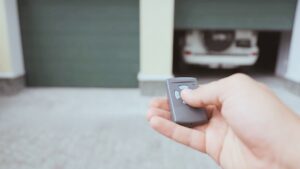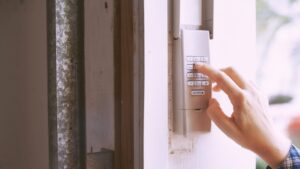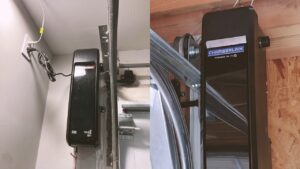Here’s a scenario: you’re about to head out for an important appointment when suddenly, your garage door grinds to a halt. Panic ensues as you realize that your timely departure is now in jeopardy. Unfortunately, this scenario is all too common, as negligence in maintenance and inspection is one of the leading causes of garage door failures.
Now, imagine if you could avoid such inconvenient and costly situations altogether. The good news is that you can! By performing a comprehensive garage door inspection at least once a year, you can keep this mechanical marvel in optimal working order and minimize the risk of unexpected malfunctions.
So, join us as we embark on a journey of safety and security, diving deeper into the intricate details of a 25-point inspection checklist for your garage door.
Why Garage Door Inspection is Crucial
To ensure your garage door functions properly and safely, it’s important to have regular inspections. Some of the things to look out for include the follo wing.
1. Proper Door Operation
The average garage door opens and closes 3-6 times daily and approximately 1,500 to 2,000 times yearly. With such frequent use, to avoid emergency repairs and ensuring the door operates smoothly and efficiently is important. For this reason, you need regular inspections to identify misalignment, worn-out parts, or imbalances hindering proper door operation.
Addressing these problems can prevent inconvenient breakdowns and extend the lifespan of your garage door system.
Connect With A Garage Expert
Connect with local experts, Compare quotes, Get the best price.
2. Safety Concerns
Faulty locks and other security vulnerabilities can make your garage door an attractive target for burglars. During an inspection, you can thoroughly examine the locking mechanism of the garage door, checking for signs of wear, damage, or weakness.
This will help you identify what needs to be repaired or replaced so your garage door can provide a strong barrier against unauthorized entry.
3. Prevention of Potential Injuries
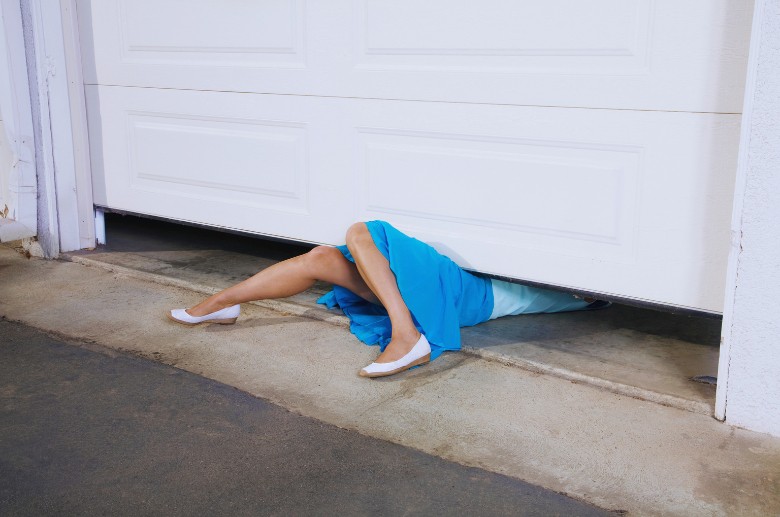
Garage doors have several moving parts, including springs, cables, and rollers, which can create pinch points. Improperly functioning or damaged components can increase the risk of fingers, hands, or other body parts getting caught or crushed.
Additionally, if the door’s supporting components, like springs or cables, wear out or are damaged, the door is likely to fall unexpectedly. Therefore, it’s vital to have regular inspections to help identify signs of wear or damage to these components, allowing for timely repairs or replacements to prevent such accidents.
4. Cost Savings from Early Detection of Issues
Did you know 89% of homeowners in the US use the garage door as their home’s main entryway? This frequent use increases wear and tear on its components, like springs, cables, rollers, and tracks, making them more prone to damage or failure.
These damaged or failing components can lead to costly consequences when you fail to attend to them on time. Regular garage door inspections can save you money in the long run by identifying and addressing issues early on.
For instance, replacing a worn-out garage door spring costs around $200 to $300. If you don’t replace the same spring on time, it can break and damage the garage door opener due to excessive strain. Replacing your damaged opener can cost between $250 and $550, which is more expensive than replacing a worn-out spring.
Garage Door Inspection Checklist
A garage door inspection checklist provides a systematic approach to examining various components of your garage door. This checklist also ensures every component functions properly and addresses every potential issue.
Safety Precautions to Take When Inspecting Your Garage Door
To ensure you stay safe when inspecting your garage door, apply the following precautions:
- Disconnect Power: Disconnect the power to your garage door opener before conducting any inspection or maintenance tasks.
- Wear Protective Gear: Use appropriate safety equipment, like safety goggles, gloves, and sturdy footwear, to protect yourself from hazards.
- Use Ladder Safely: If you need to access elevated areas during the inspection, use a sturdy and stable ladder. Also, ensure you set it up correctly and on a level surface to prevent ladder-related accidents.
- Beware of Tension: Be cautious when handling components under tension, such as springs or cables. Mishandling these parts can lead to serious injuries. We highly recommend that you seek professional assistance when dealing with these components.
- Follow Manufacturer Guidelines: Adhere to the manufacturer’s guidelines and instructions for inspecting your garage door system to ensure you follow the recommended safety procedures.
Importance of Keeping the Garage Door Area Clear of Objects and People During an Inspection
Here are more reasons why it’s essential to keep your garage door clear of objects and people during an inspection:
- Avoid Accidents: Keeping people, especially children, and pets, away from the garage door area during inspection reduces the risk of them being trapped, crushed, or injured during door operation.
- Free Visual Inspection: A clear space around the garage door allows for a thorough visual inspection of all components without any obstruction. This enhances the accuracy of the assessment.
- Prevent Damage: Removing objects from the door’s path prevents potential damage to both the objects and the garage door itself. This avoids costly repairs and ensures the longevity of the door.
Tools Needed for Garage Door Inspection
Below is a list of the tools and equipment you’ll need for this task:
- Screwdriver Set
- Pliers
- Wrenches
- Lubricant
- Flashlight
If you’re ready with your tools, here is how to proceed with inspecting each point:
1. Inspect the Door Balance

To inspect the door balance, close the garage door fully using the automatic opener or manually lower it. Locate the emergency release cord or lever and pull it to disconnect the door from the automatic opener, allowing you to operate it manually.
Lift the door manually to about halfway open and release it, paying close attention to how it responds. It’s balanced correctly if the door stays in place or moves slightly up or down. If the door closes too easily or opens with force, it could mean an issue needs to be fixed.
2. Inspect the Rollers
Worn-out rollers can cause the door to operate unevenly, increasing strain on other components and potentially compromising the door’s functionality and safety. To examine the rollers, close the garage door and disconnect it from the opener using the emergency release cord or lever.
Inspect each roller closely, looking for signs of wear, such as cracks, chips, or flat spots on the rollers. Also, confirm if the rollers spin smoothly without excessive noise or friction. If you notice any significant wear, damage, or difficulty in the roller’s movement, it may be necessary to replace the roller.
3. Inspect the Cables
Inspect the entire length of the cables, paying particular attention to the areas near the drums and bottom brackets. Look for signs of fraying or damage, such as loose strands or fraying. Also, ensure the cables are properly tensioned and not sagging excessively.
If you observe fraying or loose strands, we highly recommend seeking the assistance of a professional garage door technician for replacement.
4. Inspect the Drums
Start by visually examining drums for signs of cracking or unusual wear. Carefully observe the surface of the drums, looking for visible fractures or damage.
Pay attention to the condition of the drum’s edges, ensuring they are smooth and free from any jagged or worn-out areas. Identifying cracks or excessive wear on the drums may indicate the need for repair or replacement.
Connect With A Garage Expert
Connect with local experts, Compare quotes, Get the best price.
5. Inspect the Center Bearing
The center bearing is crucial in supporting and facilitating the door’s movement. Therefore, examine the center bearing of a garage door, and check for signs of the following:
- Wear
- Visible damage
- Discoloration
- Burned-out bearings
You can also rotate the bearing by hand to assess its smoothness and listen for any unusual grinding or squeaking sounds.
6. Inspect the Center Bracket
The center bracket provides crucial support for the garage door and helps maintain its proper alignment. Carefully examine the center bracket for signs of bending or other damage.
Look for visible deformations or irregularities and pay close attention to the area where the bracket attaches to the garage door and the garage ceiling or support structure. Also, look for signs of stress, cracks, or excessive wear in these areas.
7. Inspect the End Bearing Plates
When inspecting the end bearing plates of a garage door, examine closely for two major signs: Wear or damage. Inspect the bearing plates for dents or deformations. Also, confirm the edges and corners of the plates, as these areas are more prone to damage.
8. Spring Bar
You’ll need to pay close attention to two key aspects when inspecting the spring bar: rust and bending. Rust can weaken the integrity of the bar, potentially leading to structural issues and decreased functionality. At the same time, bending can negatively impact the garage door’s operation and may indicate the need for repair or replacement.
Inspect the entire length of the spring bar, identifying signs of rust or corrosion. Also, run your hand along the bar’s surface, feeling for any irregularities or areas where the bar may be bent or damaged.
9. Inspect the Hinges
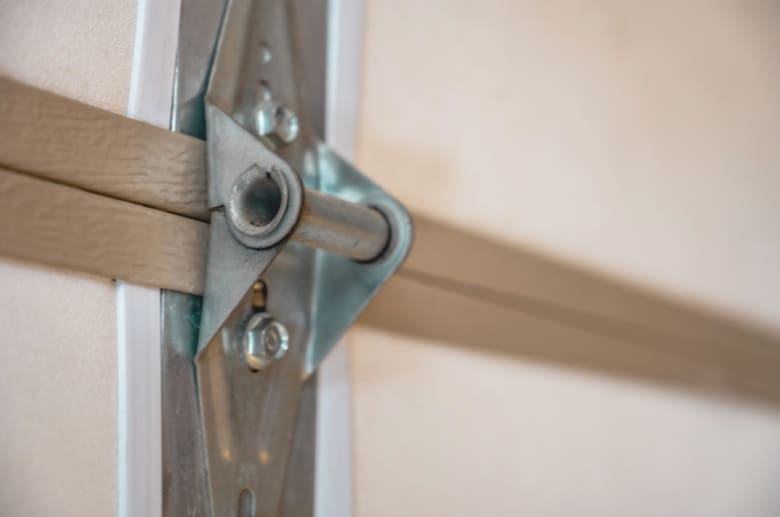
Inspect each hinge, focusing on the connection points between the door panels and the rollers. Examine for cracks, fractures, or bent metal. Also, check for loose or missing screws that secure the hinges to the door panels.
10. Inspect the Top Brackets
Top brackets are essential for the overall stability and performance of the garage door system. So, inspect each bracket, paying close attention to the areas where they are attached to the door frame or ceiling. Look for cracks, fractures, or signs of metal fatigue.
Evaluate the overall condition of the brackets, looking for signs of wear, like excessive rust or corrosion, which can weaken the brackets. Check for any bending or deformation that may affect their structural integrity.
11. Bottom Brackets
If you are wondering how to inspect the bottom brackets of a garage door, here’s how to go about it:
- Visual Inspection: Carefully inspect the brackets and track for any noticeable cracks, fractures, or deformities, especially in the areas connected to the door panels.
- Check for Loose or Missing Hardware: Inspect the hardware—everything from the bolts, screws, or nuts that secure the bottom brackets to the door and track. Ensure that they are tight and properly fastened.
- Evaluate Alignment: The bottom bracket’s alignment should be correctly and parallel positioned to each other. Misaligned or skewed brackets may indicate underlying issues with the door’s track or other components.
- Examine for Wear: Look for signs of wear, such as excessive rust or corrosion on the brackets.
12. Inspect the Vertical Tracks
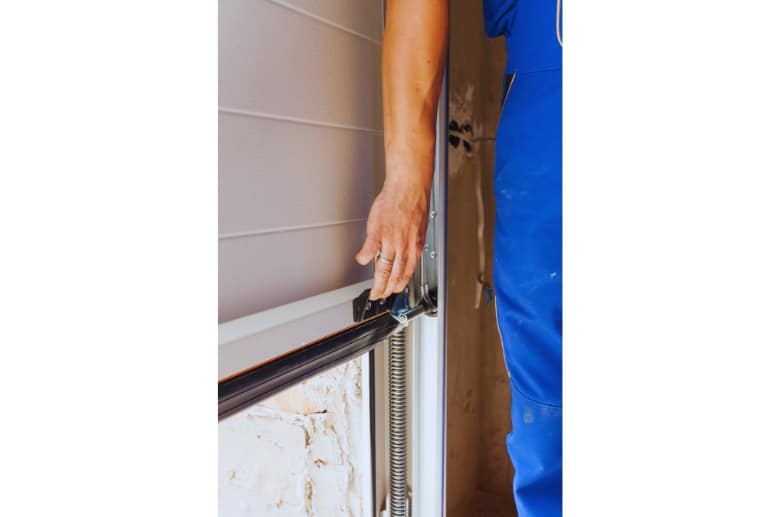
The vertical tracks guide the garage door’s movement, so you’ll need to look for dents, bends, or misalignments along the entire length of the tracks. Ensure that they are securely fastened to the wall and ceiling. Contact a professional for repairs if there are significant damages or alignment issues.
13. Horizontal Track
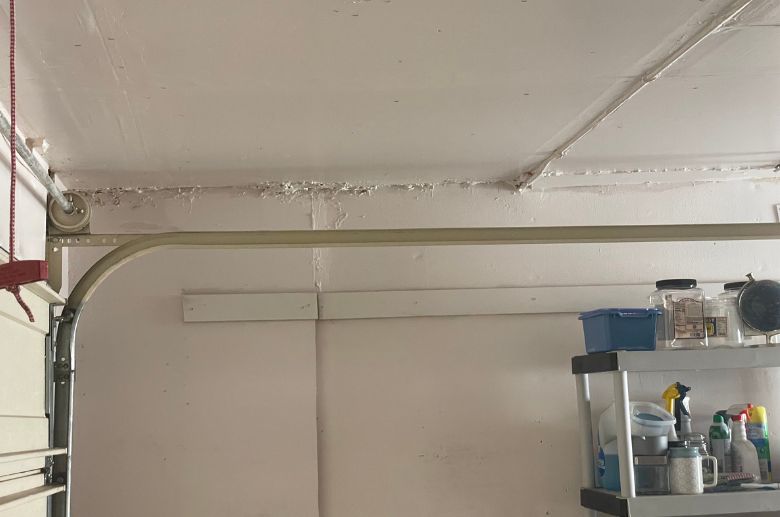
Examine the horizontal track that runs parallel to the ceiling, looking for signs of damage, like bends or dents, and ensure the track is properly aligned and securely attached. Remember, any misalignment can cause the door to bind or operate unevenly, becoming a safety hazard.
14. Jamb Brackets
Jamb brackets are located on the sides of the door and connect the tracks to the door frame. To inspect them, scan for cracks, breaks, or loose screws.
Ensure that the brackets are securely fastened and in excellent condition. If you notice damaged brackets, call your local garage door technician to help you out.
15. Inspect the Horizontal Strut
The strut helps support the door and adds stability. If your garage door has a strut, inspect it for damage or wear. If you notice a significant issue, it may affect the door’s balance and overall operation.
16. Inspect the Weather Seal
A properly functioning weather seal helps keep out dust, debris, and inclement weather. To inspect the weather seal along the bottom of the garage door, check for gaps, tears, or deterioration. If you identify a damaged or worn-out seal, consider replacing it to maintain a secure and insulated garage environment.
17. Inspect the Door Panels (interior/exterior)
Examine each panel, looking for cracks, dents, or warping. Run your hand over the surface to check for rough areas or irregularities. Additionally, examine the edges and corners of the panels, as these areas are prone to damage.
18. Inspect the Push-Button and Keypad
Inspecting your garage door push-button and the keypad is straightforward. Start by testing the functionality of the push button and keypad by pressing each button or entering a code on the keypad.
Confirm that the intended action, such as opening or closing the garage door, has been executed accurately. Also, verify that the buttons and keypad register inputs consistently and without delay. If you notice any issues with responsiveness or functionality, it may indicate a wiring or connection problem that requires professional attention.
19. Inspect the Opener Trolley/Carriage
A garage door trolley consists of a motorized carriage that moves along the opener rail, controlling the door’s opening and closing. To begin inspecting your opener trolley or carriage, activate the garage door opener. Afterward, observe the movement of the trolley as the door opens and closes.
Confirm that the trolley moves smoothly along the opener rail without jerking or hesitation. If you highlight significant damage or loose connections, seek necessary help for replacement.
20. Manual Release Handle
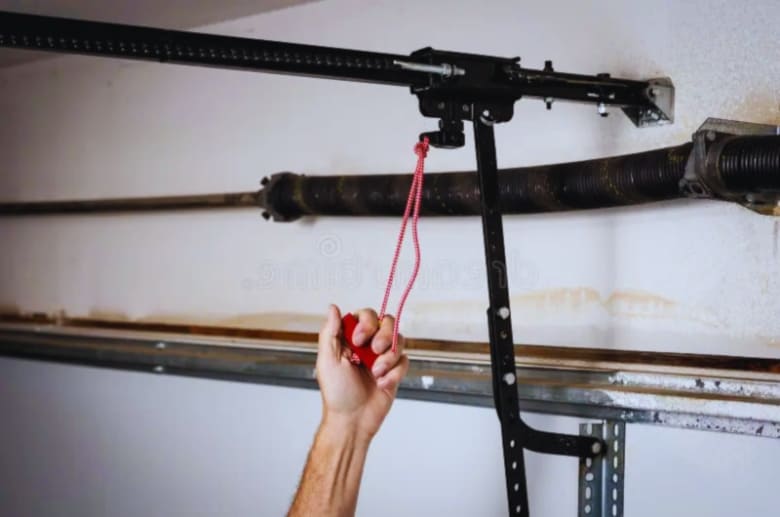
The manual release handle allows you to manually operation of the door in case of a power outage or other emergencies. Locate the manual release handle, a red cord, usually positioned near the top of the door or on the side of the opener rail.
Inspect the functionality of the manual release handle by pulling it or operating it according to the manufacturer’s instructions.
This action should disengage the trolley or carriage from the opener rail, allowing for manual garage door operation. Affirm that the handle moves smoothly and that you can manually open and close the door without obstructions or resistance.
21. Inspect the Safety Sensors

When inspecting the safety sensors of a garage door, it’s crucial to ensure their proper function and test the auto-reversal feature. Follow these steps to inspect and test the safety sensors:
- Locate the safety sensors on either side of the garage door, near the bottom.
- Examine the sensors visually to check for any physical damage, like cracks or misalignment. Ensure that the lenses are clear and free from any obstructions.
- Activate the garage door opener to close the door. Wave a long object, like a broom or rolled-up towel, in front of one of the sensors. The door should stop and reverse its direction immediately upon obstruction. If the door does not reverse or reverses sluggishly, it indicates a sensor problem.
- Also, inspect the sensor wiring for visible damage, like exposed or frayed wires. Ensure the wiring is securely connected to the sensors and the opener.
22. Inspect the Motor Gear
The gear in the motor should also be inspected regularly for signs of wear or damage. Follow these steps to inspect the motor gear:
- Check for visible signs of cracking, corrosion, and other damage on the gear.
- Ensure the teeth are intact and evenly spaced around the gear’s circumference. If any teeth appear chipped or warped, it could indicate a problem with the motor.
- Examine the shaft of the gear for any signs of wobbling or misalignment. If there is excessive wear, it may be necessary to replace the gear altogether.
Connect With A Garage Expert
Connect with local experts, Compare quotes, Get the best price.
23. Electrical Wires
When inspecting the electrical wires associated with a garage door opener, it’s crucial to perform a visual inspection to identify signs of breakage or cracking in the wire coating. Here are some steps for an effective inspection:
- Locate the electrical wires connected to the garage door opener.
- Carefully examine the entire length of each wire, paying close attention to damage to the insulation or coating.
- Ensure that the wire routing is proper and secure and that the wires are neatly organized, avoiding sharp edges or pinch points that could cause damage over time.
If you encounter damaged wires or connections during the inspection, we recommend consulting a professional electrician to address them promptly.
24. Inspect the Limit Switch
Follow these steps to inspect the limit switch effectively:
- Close the garage door completely using the garage door opener.
- Activate the garage door opener to activate the opening cycle. Observe the door as it starts to move upward. Listen to its movement as the door opens and for unusual sounds like extreme vibrations.
- Check if the door is at the correct height according to its travel limits. If the door does not open or stops before reaching the proper position, it may indicate a misaligned or malfunctioning limit switch.
25. Opening/Closing Opener Force
To inspect the opening/closing opener force, you’ll need to perform two tests to ensure that the force applied to the door is within acceptable limits.
- Non-Contact Reversal Test: This test ensures that the door’s sensors function correctly to prevent accidents or injuries. Initiate the door’s downward motion and then wave a long object, such as a broom handle, in the path of the door’s closing. The door should sense the object and automatically reverse its direction.
- Contact Reversal Test: Instead of a non-contact object, place a sturdy object, like a block of wood, on the ground where the door closes. As the door reaches the object, it should detect the obstruction and reverse its motion.
26. Inspect the Springs

Inspect the garage door springs for rust, wear, or damage. Look for corrosion, broken coils, or any deformities in the springs.
Also, measure the length of each spring to determine the weight of the garage door it supports. The spring’s tension is adjusted based on the door’s weight, so measuring the springs helps ensure proper balancing and operation of the door.
27. Warning Labels

Warning labels are vital for your safety, so ensure all the necessary elements are in place. Look for warnings about sharp edges, pinch points, moving parts, and anything else that could pose a danger. Make sure that the labels are legible and not faded or torn off.
Garage Door Inspection Frequency
Generally, we recommend conducting a comprehensive garage door inspection at least twice a year (once every six months). However, other factors might require you to conduct more frequent garage door inspections. They include the following:
- Frequent Use: If you regularly open and close your garage door multiple times a day, it can cause damage to various parts, such as the springs and cables, due to wear and tear.
- Extreme Weather Conditions: These conditions can impact the performance and integrity of the door, its hardware, and weatherstripping, making it essential to assess their condition more frequently.
- Recent Repairs or Replacements: If you recently had repairs or replacements done on your garage door system, scheduling more frequent inspections in the immediate aftermath may be beneficial. This allows for close monitoring of the repaired or replaced components, ensuring they function correctly and identifying potential issues early on.
Garage Door Maintenance Tips
Maintaining your garage door properly is important to ensure that it operates smoothly, lasts longer, and is safer. With that in mind, the following tips are crucial to consider:
1. Keep the Tracks Clean: Inspect and clean your garage door tracks regularly to remove dirt, debris, or obstructions. Use a damp cloth to wipe away grime and ensure smooth door movement along the tracks.
2. Check and Tighten Hardware: Periodically inspect the hardware, including hinges, bolts, screws, and roller brackets. Tighten any loose hardware to maintain the stability and proper alignment of the garage door.
3. Test the Balance: Test the balance of your garage door by disconnecting the opener and manually lifting the door halfway. If the door stays in place, it is properly balanced. If it falls or rises, it may indicate a balance issue that needs adjustment by a professional.
4. Inspect Cables and Springs: Inspect the cables and springs visually for signs of fraying, wear, or damage. If you notice any issues, do not attempt to repair them yourself. Contact a professional technician for safe and proper handling of these components.
5. Keep Weatherstripping in Good Condition: Check the weatherstripping along the bottom of the garage door and between door sections. Replace worn-out or damaged weatherstripping to prevent drafts, pests, and water infiltration.
Importance of Garage Door Preventive Maintenance
In addition to regular garage door inspections, there are some preventive measures you can take to experience the advantages mentioned below.
Avoid Costly Repairs
Regular maintenance allows the identification and timely resolution of minor issues before they escalate into major problems. For example, a worn-out roller or a loose hinge may seem like a minor inconvenience. However, if left unattended, it can cause additional stress on other components, leading to premature failure or damage, which can be costly to repair.
Extend Lifespan
Proper maintenance plays a vital role in extending the lifespan of your garage door and its components, reducing the need for premature replacements. For example, you can preserve your garage door system’s structural integrity and functionality by implementing regular maintenance practices, like regular lubrication and inspecting the cables and springs.
Enhance Safety and Security
Inspecting and testing safety features like the auto-reverse mechanism and the photoelectric sensors reduces the risk of accidents involving the garage door.
Additionally, preventive maintenance allows you to easily identify and resolve vulnerabilities that may make your garage door an attractive target for break-ins. This includes worn-out locks, hinges, and other security components of the door.
Maintain Warranty
Many garage doors come with warranties that require regular maintenance to remain valid. Following the manufacturer’s recommended maintenance guidelines ensures your warranty remains valid.
Importance of Regular Lubrication
Fun Fact: Did you know lubricating your door prolongs the life of your garage door?
It also offers additional benefits that include the following.
- Smooth and Quiet Operation: Proper lubrication reduces friction between moving parts, resulting in smooth and quiet garage door operation.
- Prevents Wear and Tear: Lubrication helps reduce friction and stress on the components during door operation.
- Protection Against Rust and Corrosion: Regular lubrication creates a protective barrier, preventing rust and corrosion on your garage door. This is especially crucial in areas with high humidity or exposure to moisture.
Connect With A Garage Expert
Connect with local experts, Compare quotes, Get the best price.
Garage Door Inspection Services
Garage door inspection services help you assess the condition and functionality of your garage door system. These services involve thoroughly examining various components, including the door itself.
That said, various signs can indicate that your garage door requires a professional inspection. Some of them include:
- Unusual Noises: Grinding, squeaking, or banging noises during operation could indicate a problem with your garage door components.
- Inconsistent Operation: If your garage door opens or closes partially, this may indicate underlying issues requiring a professional inspection.
- Slow or Jerky Movement: Are you experiencing slower movement than usual or experiencing jerky movements on your garage door? This may be a sign of worn-out or damaged components.
What Should You Expect From a Professional Garage Door Inspection Service?
A garage door inspection service will provide a list of items you should expect to be inspected. Some of the items include:
1. Thorough Inspection: A professional inspection involves a comprehensive examination of all relevant components of the garage door system. This includes the door, springs, cables, tracks, rollers, hinges, and safety features.
2. Expertise and Knowledge: You can expect garage door professionals to provide you with the expertise and knowledge to identify issues, diagnose problems, and provide appropriate solutions. They should also offer guidance on maintenance practices and recommend repairs or replacements if needed.
3. Detailed Assessment: A professional service will provide you with a detailed assessment of the condition of your garage door system. This includes informing you about any existing problems, potential risks, and recommendations for maintenance or repairs.
4. Timely Repairs: You get timely repairs using the right tools and techniques if any issues are detected during the inspection. The pros can do the necessary repairs correctly, enhancing the safety and functionality of your garage door.
5. Peace of Mind: By hiring a professional service, you know your garage door has been inspected and serviced by experts. This ensures your garage door system’s safety, security, and reliable operation.
Risks of DIY Repairs
Engaging in DIY repairs for your garage door may seem like a cost-saving approach. However, it often comes with significant risks, including the following:
- Personal Safety: Garage door systems involve heavy components, such as springs, under high tension. DIY repairs without proper knowledge and tools can pose a significant risk of injuries.
- Improper Diagnosis: Without the expertise of a professional, it can be easier to diagnose the root cause of a problem accurately. This may result in counterproductive repairs or further damage to the door and its components.
- Lack of Specialized Equipment: Garage door repairs often require specialized tools and equipment that may not be readily available at your disposal. Using improper tools can lead to subpar repairs or additional damage.
- Voiding Warranty: Attempting DIY repairs without proper authorization can void any existing warranties on the garage door or its components. This may result in additional costs if major repairs or replacements are needed.
What is the Cost of Garage Door Inspection?
A professional garage door inspection typically costs $100 to $250, with an average of $175. However, the overall cost depends on various factors such as location, size of the door, and additional services provided.
This cost includes a thorough examination of the door and its components, identification of any problems, and a detailed assessment of its condition.
Conclusion
Regularly inspecting your garage door is crucial for ensuring its proper operation, safety, and prevention of potential injuries. These inspections can also save money by detecting issues early and extending the door’s lifespan and its components.
We highly recommend that you prioritize regular garage door inspection as it promotes safety, security, and the longevity of their garage door system.
Schedule a professional inspection service to ensure your garage door’s optimal functionality and reliability and a well-maintained entryway to your home.

